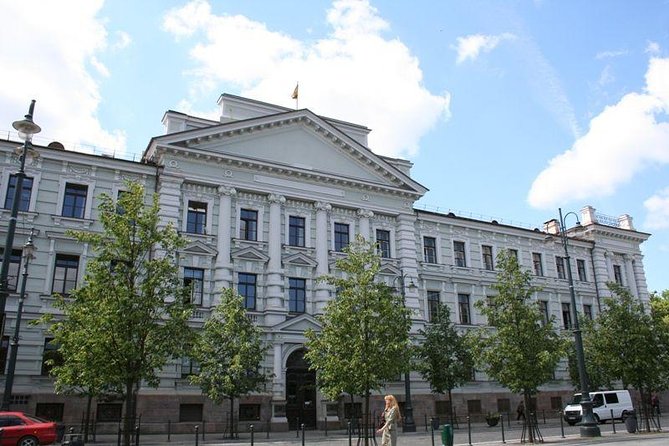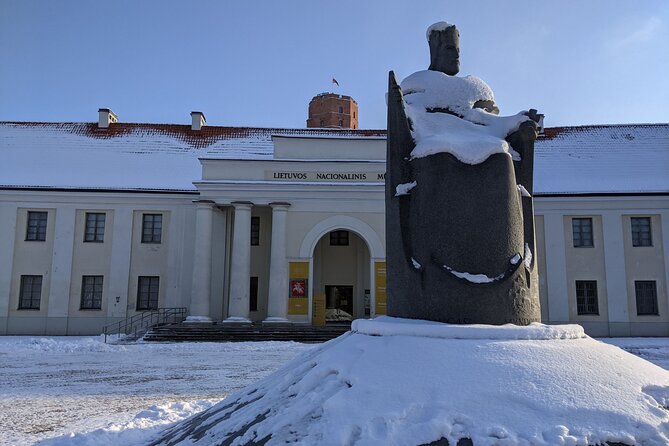Lithuania’s tumultuous past is etched into the very fabric of Vilnius, its captivating capital city. The "Vilnius Signs of History: Long Way to Freedom" guided tour offers a poignant window into this nation’s arduous journey, from the harrowing realities of Soviet occupation to the hard-won triumph of EU membership in 2004. Participants will explore the profound impact of these events, exploring sites like the KGB Museum that reveal the human rights abuses endured by Lithuanians. As the tour unfolds, one can’t help but be inspired by the resilience and cultural spirit that defines this remarkable country. There’s much more to uncover in this thought-provoking exploration of Lithuania’s path to independence.
Key Points

- Explore the KGB Museum in Vilnius, showcasing the repression and human rights abuses endured during the Soviet occupation of Lithuania.
- Discover monuments throughout Vilnius that commemorate Lithuania’s long struggle for independence, from the Russian Empire to the Soviet Union.
- Understand how Lithuania’s path to regaining independence in 1990 and joining the European Union in 2004 marked a pivotal transition for the nation.
- Gain insights into the crucial role played by the Catholic Church in preserving Lithuanian culture and identity during the Soviet era.
- Experience a guided tour that highlights the significant landmarks and pivotal events that shaped Lithuania’s turbulent past and its long journey to freedom.
Lithuania’s Turbulent Past

What shaped Lithuania’s tumultuous past? A history marked by foreign occupation and struggle for independence.
Lithuania was controlled by the Russian Empire for over a century, then fell under Soviet rule after World War II. This led to 50 years of harsh communist suppression, with many Lithuanians deported to Siberian gulags.
The country finally regained independence in 1990 amid the collapse of the Soviet Union. Today, Lithuania is a proud member of the European Union, having overcome a challenging journey to become a democratic, free-market society.
The scars of this past can still be seen across Vilnius, particularly at the KGB Museum, a poignant reminder of the nation’s hard-won freedoms.
You can also read our reviews of more tours and experiences in Vilnius.
Soviet Occupation and Resistance

How did Lithuania fare during the Soviet occupation?
The Soviet takeover in 1940 was devastating for the Baltic nation. Lithuania lost its independence and fell under harsh Soviet rule for over 50 years. The KGB suppressed dissent, deported thousands to Siberia, and brutally quashed independence movements.
Yet Lithuanians fiercely resisted, forming anti-Soviet underground groups and staging protests. The Catholic Church played a key role, preserving Lithuanian culture and identity.
In 1990, Lithuania became the first Soviet republic to declare independence, marking a pivotal moment in its long struggle. Though the path was arduous, Lithuania’s unwavering spirit and determination ultimately prevailed, reclaiming its rightful place as a free and sovereign state.
Path to European Union
After regaining independence in 1990, Lithuania set its sights on joining the European Union, a longstanding aspiration shared by many in the Baltic nation.
This path wasn’t without its challenges, as Lithuania had to undertake significant economic and political reforms to meet the EU’s accession criteria.
The country’s determination paid off, and in 2004, it became a full member of the European Union.
This milestone marked a new chapter in Lithuania’s history, paving the way for greater integration, economic opportunities, and a stronger voice on the European stage.
The journey had been long, but the hard-fought inclusion in the EU solidified Lithuania’s place as a proud, independent nation within the European family.
Exploring KGB Museum
The KGB Museum is a somber yet compelling highlight of the Vilnius tour, offering visitors an in-depth look into Lithuania’s tumultuous history under Soviet occupation.
The museum is housed in the former headquarters of the Lithuanian Soviet Socialist Republic’s Committee for State Security, or KGB, and features:
-
Chilling exhibits that document the agency’s widespread human rights abuses, including interrogation rooms and execution chambers.
-
Personal artifacts and testimonies from victims, providing a powerful firsthand account of the repression and oppression endured by the Lithuanian people.
-
Insights into the KGB’s extensive surveillance and control over every aspect of citizens’ lives, underscoring the heavy price paid for Lithuania’s independence.
Exploring the KGB Museum leaves a lasting impact, reminding visitors of the fragility of freedom and the importance of vigilance in safeguarding civil liberties.
Monuments of Independence
Dotting the cityscape of Vilnius are a series of monuments that commemorate Lithuania’s hard-won independence. These memorials stand as powerful reminders of the nation’s struggle against Soviet occupation and its eventual restoration of sovereignty.
One of the most prominent is the Monument to Freedom, a towering sculpture depicting a Lithuanian knight on horseback. Nearby, the Statue of Adam Mickiewicz, a renowned Polish-Lithuanian poet, honors the country’s rich cultural heritage.
These landmarks serve as poignant testaments to Lithuania’s resilience, inviting visitors to reflect on its tumultuous past and celebrate its hard-earned freedom. They underscore the resilience of the Lithuanian people and their unwavering commitment to self-determination.
Guided Tour Highlights
For visitors seeking a deeper understanding of Vilnius’ turbulent history, the guided tour offers a compelling exploration of the city’s most significant landmarks.
The tour highlights three key aspects of Lithuania’s past:
- The Soviet occupation, with a visit to the chilling KGB Museum.
- The country’s inclusion in the European Union, and the path to regaining independence.
- The pivotal events that unfolded over the past 50 years, brought to life through the guide’s engaging commentary.
With a small group size and a professional, knowledgeable guide, this tour provides an immersive and insightful glimpse into Vilnius’ complex and profound history.
Practical Information for Visitors
Typically, the tour meets at the Cathedral Clock Tower in central Vilnius, providing a convenient starting point for participants.
The tour then takes visitors to the KGB Museum, available Wednesday through Sunday, offering a chilling look into Lithuania’s Soviet occupation.
The tour concludes at the Museum of Occupations and Freedom Fights, exploring the country’s long struggle for independence.
Priced from $69.87 per person, the small-group walking tour caters to those with a moderate fitness level.
Cancellation is free up to 24 hours before the experience, and confirmation is provided within 48 hours of booking, subject to availability.
Public transportation is nearby, though the tour isn’t wheelchair accessible.
Frequently Asked Questions
How Long Is the Walking Tour?
The walking tour doesn’t specify an exact duration, but it’s described as focusing on Lithuania’s history over the past 50 years with stops at key sites like the KGB Museum. The tour is likely several hours long.
What Time Does the Tour Start?
The walking tour doesn’t specify a start time. However, the meeting point is the Cathedral Clock Tower, and the tour ends at the Museum of Occupations and Freedom Fights, so it’s likely to run during regular business hours.
Are There Any Restroom Breaks During the Tour?
The tour includes restroom breaks during the approximately 3-hour walking tour. The guide ensures participants have opportunities to use facilities at various points throughout the experience.
Can We Take Photos Inside the KGB Museum?
You’re generally allowed to take photos inside the KGB Museum, though some specific exhibits may restrict photography. It’s best to check with the guide or museum staff for any specific photography guidelines during the tour.
Is There an Option for a Private Tour?
Yes, there’s an option for a private tour. The tour operator offers a private walking tour of Vilnius that focuses on the city’s history, with the KGB Museum visit included. Pricing varies based on the group size.
Recap
The "Vilnius Signs of History: Long Way to Freedom" tour offers a profound exploration of Lithuania’s tumultuous past and inspiring journey towards independence. Visitors reflect on the nation’s resilience, from Soviet oppression to EU membership, celebrating the enduring spirit of freedom that defines Lithuania today. This guided experience provides a poignant look into the country’s rich cultural heritage and the ongoing fight for self-determination.
More Tour Reviews in Vilnius
Not for you? Here's more things to do in Vilnius we have recnetly reviewed
- 2 Best Guided Tours In Vilnius
- 2 Best Full-Day Tours In Vilnius
- Small Group Anyksciai Regional Park Day Trip From Vilnius
- Day Trip From Vilnius to Curonian Spit National Park
- Skip the Line: Europos Parkas, Open-Air Museum Ticket Vilnius, Lithuania
- Cinematic Vilnius: Revisiting Famous Chernobyl Filming Locations
- Half Day Private Tour of Trakai From Vilnius
- Route of John Paul Ii: Hill of Crosses, Tytuvenai, Shrine of Our Lady of Siluva
- Explore Vilnius in 60 Minutes With a Local
- Vilnius Day Trip to Dzukija National Park Including Grutas Park
- Exclusive Dinner in a Hot Air Balloon
- Highlights of the Baltic States in 8 Days (Private Tour)
